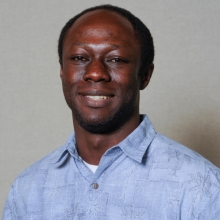MSE 298 Seminar (Zoom): Tuning Transport and Magnetism at Polar Oxide Interfaces

Assistant Professor
Department of Physics
North Carolina State University
Zoom: Meeting ID 842 506 6501, Passcode 587901
Abstract: Atomic-scale interactions at the interfaces between polar and nonpolar transition-metal oxides have led to the realization of exciting phenomena including two dimensional electron gases, superconductivity and interfacial magnetism. However, these interactions may lead to the suppression of electronic and magnetic ordering at interfaces with strong structure-property relationships. By imaging the atomic structure of the interface between polar LaSrMnO3 (LSMO) and nonpolar SrTiO3, we identify interfacial structural distortions that are correlated with thickness-dependent metal-insulator and ferromagnetic-paramagnetic transitions in the rare-earth manganites. We show that these structural distortions can be tuned by inserting polarity-matched spacer layers at the LSMO interfaces leading to a stabilization of ferromagnetism in LSMO layers as thin as two unit cells. The stabilized magnetism is found to be independent of strain. We employ a combination of synchrotron X-ray diffraction, temperature-dependent magnetization measurements and X-ray magnetic circular dichroism to elucidate the interplay between structural and spin degrees of freedom in the rare-earth manganites.[1,2] Additionally, we find that by tuning growth and post-growth processing conditions, a two-dimensional electron gas (2DEG) forms at the interface between antiferromagnetic LaCrO3 and SrTiO3, providing a route to design all-oxide heterostructures that couple magnetic ordering with the mobile carriers within the 2DEG.[3] These results demonstrate the intimate role of picometer-scale structural distortions on the physical properties of transition-metal oxides and have important implications for designing novel quantum materials. [1] Koohfar et. al., npj Quantum Materials 4 (1), 25 (2019). [2] Koohfar et. al., Physical Review B 101 (6), 064420 (2020). [3] Al-Tawhid et. al., AIP Advances 10 (4), 045132 (2020)
Bio: Divine Kumah received his doctorate in applied physics from the University of Michigan in 2009 and did postdoctoral research at the Center for Research in Interface and Surface Phenomena at Yale University. His research interests are in experimental condensed matter physics and are aimed at understanding the novel properties that emerge at the interfaces between crystalline materials. The Kumah Research Group at NC State uses state-of-the-art atomic layer-by-layer deposition techniques including molecular beam epitaxy to fabricate thin crystalline oxide films. The group is focused on understanding how atomic-scale structural distortions at interfaces can be manipulated to induce novel electronic and magnetic phenomena and the development of pathways for harnessing these unique functionalities for electronic and energy applications. Tools used by the group include atomic force microscopy, electron diffraction and synchrotron-based X-ray spectroscopy and diffraction.
Share
Related Content
| Attachment | Size |
|---|---|
| 166.66 KB |
Upcoming Events
-
EECS Seminar: Less Compute, More Intelligence – Efficient and Autonomous Generative AI and Agents
-
MAE 298: Microscopic Robots that Sense, Act and Compute
-
CBE 298 Seminar: Interface Modification for Electrocatalysis
-
CEE Ph.D. Defense Announcement: Machine Learning and Remote Sensing for Environmental Modeling - From Large-Scale Streamflow Forecasting to Malaria Risk Mapping
-
CBE Special Seminar: Operando Electrochemical Methods at Dynamic Energy Materials Interfaces
